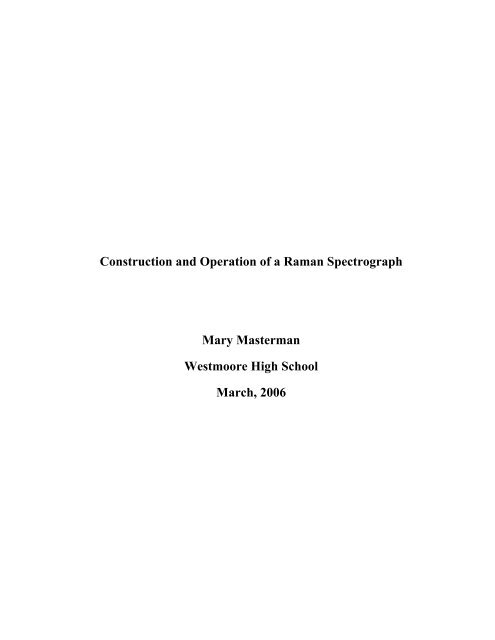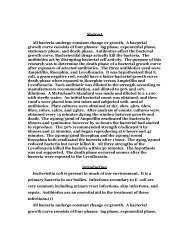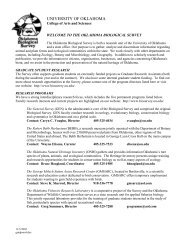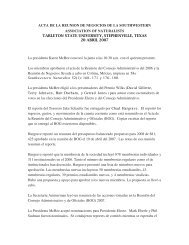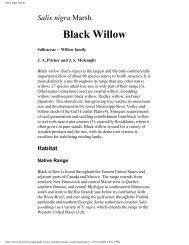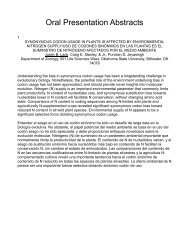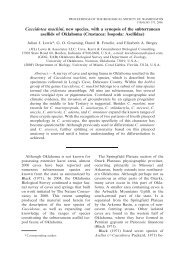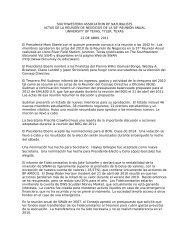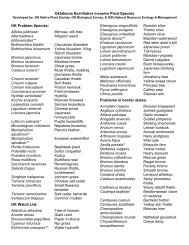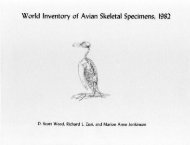Mary Masterman - Oklahoma Biological Survey - University of ...
Mary Masterman - Oklahoma Biological Survey - University of ...
Mary Masterman - Oklahoma Biological Survey - University of ...
Create successful ePaper yourself
Turn your PDF publications into a flip-book with our unique Google optimized e-Paper software.
Construction and Operation <strong>of</strong> a Raman Spectrograph<br />
<strong>Mary</strong> <strong>Masterman</strong><br />
Westmoore High School<br />
March, 2006
Abstract<br />
2<br />
Previously a low-resolution, classical spectrograph with a resolution <strong>of</strong> about 700 and a spectral range <strong>of</strong> about 200 nm was<br />
constructed.<br />
A Raman system was built for the above spectrograph. It used a green 532 nm laser to stimulate Stokes scattering in samples.<br />
The laser beam was reflected <strong>of</strong>f a dichroic mirror at an angle <strong>of</strong> 90°. A microscope objective then focused the laser beam onto the<br />
sample and collimated the returning light. Light <strong>of</strong> the laser wavelength was filtered out by an interference filter that reduced the<br />
laser signal by approximately 10 5 . A 50 mm f.l. lens then focused the waveshifted light on the entrance slit <strong>of</strong> the spectrograph.<br />
Measured wavenumbers correlated well to those in published spectra. Difficulties included false spectral lines created by the<br />
multimode laser and fluorescence in many samples.<br />
A Littrow spectrograph was then constructed. A medium-format 200 mm lens was used as a combined collimation and camera<br />
lens. A body, utilizing a diagonal mirror, connected the lens with the camera. The modular design facilitated interchanging <strong>of</strong> the<br />
lens, camera, and grating holder with different models. An adjustable slit was created, with light entering through a standard SCTthread<br />
adapter. The spectrograph could be mounted directly to the Raman head or used in other applications, including astronomy.<br />
The F/4.8 spectrograph had a resolution <strong>of</strong> 6500 and a spectral range <strong>of</strong> 80 nm with a 1200 l/mm grating. The spectrograph was<br />
tested with a consumer DSLR camera as well as a cooled CCD camera.
3<br />
Introduction<br />
Objectives<br />
• To construct a Raman spectrograph system using a Raman head consisting <strong>of</strong> a set <strong>of</strong> filters and a sample holder,<br />
appropriate lenses, and an appropriate excitation laser, to be attached to a spectrograph.<br />
• To build a medium- to high-resolution inexpensive amateur Littrow spectrograph to be attached to the Raman head.<br />
• To test the Raman system with various Raman standards and make any modifications as necessary.<br />
Theory<br />
Raman spectroscopy, like infrared spectroscopy, is a form <strong>of</strong> vibrational spectroscopy. The Raman effect occurs when a photon<br />
striking a molecule excites an electron into a higher “virtual” energy level, and the electron decays back to a lower level, emitting a<br />
scattered photon (6). Unlike infrared spectroscopy, which results from a change in the dipole moment, Raman scattering results<br />
from changes in the polarizability <strong>of</strong> a molecule.<br />
In Raman, a high-intensity beam <strong>of</strong> light is directed to a sample. The vast majority <strong>of</strong> the light is scattered elastically (Rayleigh<br />
scattering) and the reflected light has the same wavelength as the incident light. A very small portion <strong>of</strong> the scattered radiation,<br />
however (on the order <strong>of</strong> 10^-7) is shifted to a different wavelength. The scattered photons are known as Raman scattering. A few<br />
are shifted to higher energy wavelengths (anti-Stokes radiation) but most are shifted to lower frequencies (Stokes radiation) (6). If a<br />
molecule is in its ground state when it interacts with the beam <strong>of</strong> light, some energy from the colliding photon can be channeled into<br />
the vibrational mode <strong>of</strong> the molecule, causing the light to be absorbed and then re-emitted at a lower frequency (Stokes scattering).<br />
If a molecule is in a vibrationally excited state when it interacts with the beam <strong>of</strong> light, the interaction can cause it to drop to the<br />
ground state and lose some <strong>of</strong> its vibrational energy to the re-emitted (high frequency) light. (3) Stokes scattering is much more<br />
common than anti-Stokes, because at normal temperatures, electrons are most likely to be in their lowest energy state (a result <strong>of</strong> the<br />
Boltzmann energy distribution) (6). A spectrum <strong>of</strong> anti-Stokes scattering is identical in pattern, but much less intense, than a<br />
spectrum <strong>of</strong> Stokes scatterings;for this reason, only Stokes scattering is typically used in Raman spectroscopy. (Fig. 1)<br />
Fig. 1 - Spectrum <strong>of</strong> CCl 4 demonstrating the symmetry <strong>of</strong> Stokes and Anti-Stokes bands (4).
Raman Instrumentation<br />
4<br />
Raman systems are generally composed <strong>of</strong> several main parts, as follows.<br />
A. The excitation source (laser).<br />
Lasers make modern Raman feasible because they give a coherent beam <strong>of</strong> monochromatic light and can have very high power.<br />
They must be <strong>of</strong> sufficient intensity to produce the desired and detectable amount <strong>of</strong> Raman scatter, and they should be free <strong>of</strong><br />
extraneous bands. They should thus exhibit good wavelength stability and low background emission.<br />
The frequency <strong>of</strong> a Raman shift is independent <strong>of</strong> the laser wavelength used for excitation. This is an important concept in<br />
Raman. In Raman, unlike electronic spectroscopy, wavelengths are not normally measured in Angstroms or nanometers. Since the<br />
frequency shift, not the actual frequency, is what is important, Raman spectra are generally plots <strong>of</strong> intensity versus wavenumber:<br />
, where c is the speed <strong>of</strong> light in cm/s and v is the frequency in s^-1. (4) Since it is independent<br />
<strong>of</strong> the laser wavelength, the wavenumber will be the same for a 532 nm or a 785 nm laser. The wavelength difference for a<br />
particular band, however, is not necessarily the same. For instance, a wavenumber <strong>of</strong> 1000 cm^-1 for a 532 nm laser would result in<br />
a Stokes band ~30 nm away from the laser line. But the same wavenumber for a1064 nm laser would result in a Stokes band ~130<br />
nm away from the laser line.<br />
Intensity <strong>of</strong> the Raman signal is inversely proportional to the 4 th power <strong>of</strong> the laser wavelength (3):<br />
. It would seem,<br />
then, that laser radiation <strong>of</strong> a high frequency would be ideal. However, since samples tend to fluoresce at higher-frequency<br />
wavelengths, and since fluorescence is a much more efficient process than Raman, this is not necessarily true. Thus, infrared lasers<br />
have become increasingly popular in Raman, despite their low frequencies. On the other hand, it has also been demonstrated that at<br />
wavelengths under 260 nm, there is essentially no fluorescence interference (3); so ultraviolet lasers have the benefits <strong>of</strong> stimulating<br />
strong Raman scattering and not causing samples to fluoresce.<br />
B. System to irradiate sample and collect scattered light (three types <strong>of</strong> filters).<br />
Light from the laser is generally passed through an excitation filter in Raman systems. The excitation filter purifies the laser<br />
beam by permitting light only <strong>of</strong> a very small selected wavelength range to pass through, eliminating background emission (1).<br />
Excitation filters may be Short-Wave-Pass (only extraneous light <strong>of</strong> longer Stokes wavelengths than the laser is blocked) or Laser-<br />
Line (extraneous light <strong>of</strong> wavelengths shorter and longer than the laser is blocked) (5).<br />
After passing through an excitation filter, the laser beam is usually focused on the sample in order to increase the intensity <strong>of</strong> the<br />
electric field on the sample surface (the magnetic component <strong>of</strong> the electromagnetic radiation is generally not relevant to Raman)<br />
(4). Raman scattered light is then collected and passed through a barrier filter. The barrier filter prevents Rayleigh-scattered light <strong>of</strong><br />
the same wavelength as the laser form passing on to the slit <strong>of</strong> the spectrograph (the Rayleigh scattering is so much more intense<br />
than the Raman that it would saturate the CCD chip).
Barrier filters may be Long-Wave-Pass (only Stokes radiation may pass through) or Notch (both Stokes and anti-Stokes<br />
5<br />
radiation may pass through) (5).<br />
A third type <strong>of</strong> filter, known as a dichroic mirror, reflects light <strong>of</strong> the wavelength <strong>of</strong> the laser and allows Raman scattering to pass<br />
through it. It is (sometimes) used between the excitation and barrier filters at an angle <strong>of</strong> 45 degrees, to direct the laser beam to the<br />
sample.<br />
There are a variety <strong>of</strong> optical configurations for the Raman probe head. The filters can be arranged so that the scattered Raman is<br />
collected at an angle <strong>of</strong> 90 degrees or 180 degrees from the incident laser beam; (4) they can also be arranged so that the scattered<br />
light is collected at an oblique angle, as on the previous page.<br />
Fig. 2 - Graph <strong>of</strong> notch excitation filter (5).<br />
Fig. 3 - Graph <strong>of</strong> barrier<br />
long-wave-pass filter (5).<br />
C. Lens to collect scattered light, spectrograph, and collecting device.<br />
A lens collects the Raman scattered light coming through the dichroic mirror and focuses it to the slit <strong>of</strong> a spectrograph. The<br />
spectrograph built in this project is known as a Littrow spectrograph, meaning that it uses just one lens as a collimation lens for the<br />
Raman light and as a lens to focus the dispersed light onto the collecting device (a camera). (2) A device must be built to hold the<br />
grating in place / allow it to be tilted, preferably with a stop so that the grating can be flipped between first and zeroth order.<br />
Basically the job <strong>of</strong> the spectrograph is to transform the Raman light into a spectrum, which, upon being collected by the camera /<br />
processor, can be analyzed by a spectral processing program.
Materials and Methods<br />
6<br />
Primary Materials<br />
Drill press with various drill bits, C-clamps, taps, and screws; Lathe with 3-jaw and 4-jaw chucks; Various scrap aluminum<br />
tubing, L-brackets, and plates; Black foamie w/ double-stick tape; Canon EOS 300D digital camera; 300 mm medium-format<br />
camera lens; Mounting board with aluminum rails; 1200 lines / mm 5 cm^2 diffraction grating; Vice and files; Saw; Hand-drill;<br />
Canon 50 mm camera lens; Chroma Corporation filter set (including barrier filter, excitation filter, and dichroic mirror); Thin brass<br />
sheet to hold dichroic mirror in place; Canon 67 mm filter to hold barrier filter; 532 nm 5 mW green laser; Red laser, level, and ruler<br />
(for calibration); Flat diagonal mirror with adjustment screws; Micrometer head (to adjust angle <strong>of</strong> grating).<br />
Methods<br />
Build Raman filter cube using square aluminum tubing. Carefully contruct brass sheet to hold dichroic mirror and drill holes in<br />
filter cube for other filters. Very carefully, and with gloves, slide dichroic mirror into brass sheet so that it is at a 45° angle to filter<br />
cube. Construct mounting board for Raman system using large wood board and aluminum rails. Attach lenses to rails using L-<br />
brackets and and attach to mounting board. Construct holder for laser using aluminum tubing and screws. Attach barrier filter to lens<br />
using 67 mm filter holder. Attach excitation filter to laser holder. Align optical system.<br />
Construct backing-ring to attach Pentax 6x7 ring to Canon EOS 300D Camera. Construct holder for diagonal on lathe using<br />
round aluminum tubing. Attach diagonal mirror to holder using double-stick tape. Construct grating holder using micrometer head,<br />
brass rod for grating to turn on, and part <strong>of</strong> an aluminum L-bracket. Attach grating with double-stick tape. Align optical system.<br />
Attach spectrograph to Raman head. Collect spectra. In the Raman system, the dichroic mirror was not initially at the correct 45º<br />
angle, so that the filter cube had to be made tiltable and separate holders for the barrier and excitation filters had to be constructed.<br />
Due to the necessity <strong>of</strong> placing the invisible Raman signal on the slit <strong>of</strong> the spectrograph, alignment <strong>of</strong> the Raman system’s<br />
optical path was very challenging. The Raman system didn’t work at all until the sample focusing lens was replaced with a<br />
microscope objective, which presumably dramatically intensed the intensity <strong>of</strong> the laser beam on the sample. It was very difficult to<br />
design the Littrow spectrograph such that the diagonal and SCT ring would fit in the flange-to-film distance <strong>of</strong> the lens, partly<br />
because the distance was not as published.<br />
Alignment <strong>of</strong> the diagonal mirror so that the entrance image <strong>of</strong> the spectrograph resulted in a centered and focused image on the<br />
camera chip proved to be tedious.
Fig. 4 – My diagrams <strong>of</strong> spectrograph system. At the top, top and side diagrams <strong>of</strong> the Littrow spectrograph are shown. A photo <strong>of</strong><br />
that system is on the bottom right. A photo <strong>of</strong> the Raman system is on the bottom left.<br />
7
Results<br />
8<br />
Aromatic ring breathing at<br />
1004 cm^-1<br />
Wavenumber (cm^-1)<br />
Fig. 5 - 10 second spectrum <strong>of</strong> toluene gathered with spectrograph. The mercury calibration spectrum is superimposed.<br />
Fig. 6 - Actual raw image acquired by spectrograph.<br />
Fig. 7 - Molecular structure <strong>of</strong> toluene. The aromatic<br />
benzene ring associated with the band at 1004 cm^-1 is<br />
visible. the lines in the toluene spectrum above are due to<br />
the vibrational stretching <strong>of</strong> some <strong>of</strong> the bonds in toluene<br />
upon interaction with the laser beam.
Discussion <strong>of</strong> Results<br />
9<br />
Eventually, both the Raman head and the Littrow spectrograph were successfully constructed and attached. Raman spectra <strong>of</strong><br />
various substances, including standard Raman chemicals like acetone and toluene and also other various materials, including ethyl<br />
alcohol, glass, diamond, acetaminophen (Tylenol), and Teflon, were successfully observed. With many materials, fluorescence was<br />
a problem, probably due to the relatively high frequency (as compared to infrared) <strong>of</strong> the laser. Spectra were calibrated with a<br />
mercury lamp, and the observed wavenumbers for various lines in the spectra correlated very well with published wavenumbers.<br />
The resolution <strong>of</strong> the Littrow spectrograph with the 1200 lines/mm grating was about 7000, and the range was about 300<br />
Angstroms, which turned out to be enough to cover most <strong>of</strong> the desired spectral range with Raman. It did prove to be a challenge to<br />
maximize the intensity <strong>of</strong> the Raman signal, especially with the higher resolution spectrograph and the very thin slit required <strong>of</strong> the<br />
higher resolution setup; but when exposure lengths were adjusted, spectra could still be successfully obtained <strong>of</strong> molecules with<br />
pronounced Raman resonances.<br />
After the Raman spectrograph system was completed, the main obstacle to good spectra proved to be an unexpected one: all <strong>of</strong><br />
the Raman lines, as it became apparent as I narrowed my slit and got higher resolution spectra, did not have sharp, well-defined<br />
pr<strong>of</strong>iles as described in the literature but instead were complex blends <strong>of</strong> three or four peaks. At first I attributed this to some flaw <strong>of</strong><br />
the Littrow spectrograph, which was actually producing lines with a slight ghost on the red side (perhaps because <strong>of</strong> the highergroves<br />
per mm diffraction grating). I noticed, however, that the laser line in particular was characterized by the complex pr<strong>of</strong>ile, and<br />
the mercury lamp calibration lines were not. When I took spectra <strong>of</strong> the laser line by itself, without any filters, I saw that it was not<br />
outputting light at one specific frequency, but rather at several, and that—since Raman frequencies are independent <strong>of</strong> the laser<br />
frequency—the Raman lines were mimicking the same spectral pr<strong>of</strong>ile. To produce better quality Raman spectra, I would need a<br />
more expensive single-mode laser.<br />
Since a laser line was visible in most <strong>of</strong> the spectra obtained, I wondered what the attenuation <strong>of</strong> the laser line by the barrier filter<br />
was. It was found the ratio <strong>of</strong> the laser line intensity to the intensity <strong>of</strong> the blocked laser was 1.25 * 10 5 , with a 3.5% error (over two<br />
trials). When the intensity <strong>of</strong> the Raman signal for toluene, an enthusiastic Raman scatterer, was compared to the computed,<br />
normalized full-intensity laser beam, it was found that the ratio between the intensities <strong>of</strong> the Raman Stokes scattering and the laser<br />
line was 3.7 * 10 -6 . This was comparable to the 10 -6 or 10 -7 value mentioned in the literature.
Conclusion and Recommendations<br />
10<br />
In the end, a Raman spectrograph system was successfully constructed. The process <strong>of</strong> building the Raman head was difficult,<br />
especially the optical alignment, and only through trial and error were Raman spectra finally achieved. The Littrow spectrograph<br />
(attached to the Raman head) still proved to be more difficult to construct than the Raman head due to the even more complicated<br />
process <strong>of</strong> optical alignment associated with the diagonal mirror between the collimation lens and the camera chip. Optical<br />
alignment <strong>of</strong> the Raman system was difficult due to the faintness <strong>of</strong> the Raman signal (it is invisible to the naked eye, so it is<br />
difficult to get the signal aligned on the slit <strong>of</strong> the spectrograph). The difficulty associated with accounting for the small backfocus<br />
<strong>of</strong> my digital camera proved to be a severe problem. The Littrow spectrograph produced spectra that were higher resolution than the<br />
classical spectrograph constructed in my previous project; however, all in all, I would say that the difference in resolution and<br />
spectral dispersion were not worth the added trouble <strong>of</strong> building and collimating the new spectrograph. Still, the idea that Raman<br />
spectrographs—high or low resolution ones—might be someday constructed for very wide-ranging industrial applications and for a<br />
relatively small cost is very exciting.<br />
In the future I would like to create a program to quicken data analysis <strong>of</strong> spectra produced by the Raman system, and even write<br />
a program to use least-squares analysis to automatically determine the composition <strong>of</strong> compounds using a library <strong>of</strong> Raman spectra<br />
<strong>of</strong> common compounds. I would also like to examine the relationship between compound concentration and intensity <strong>of</strong> the Raman<br />
signal, which theoretically are directly proportional. This will require a carefully alignable sample holder, with a constant thickness,<br />
since the Raman signal varies depending on how much <strong>of</strong> the sample the laser light passes through. I would like to experiment with<br />
the sample holder and the laser alignment to see if the Raman signal can be maximized.<br />
Raman spectroscopy has an amazingly diverse array <strong>of</strong> applications in society, including analysis <strong>of</strong> synthetic polymers like<br />
rubber, identification <strong>of</strong> legal and illegal drugs (forensics) and identification <strong>of</strong> explosives, determination <strong>of</strong> unsaturation in food<br />
oils and fats, determination <strong>of</strong> defects in semiconductors; in-situ measurements <strong>of</strong> rocks and minerals during planetary missions,<br />
real-time detection / diagnosis <strong>of</strong> cancer, and analysis <strong>of</strong> artwork. These applications pose a seemingly unlimited number <strong>of</strong><br />
potential project ideas, and emphasize the significance that amateur Raman spectroscopy could have on the entire field.
11<br />
Acknowledgement<br />
I would like to thank Chroma Corporation for courteously donating me a set <strong>of</strong> Raman filters, including a dichroic mirror, barrier<br />
filter, and excitation filter, for use in my research; without these filters, my project probably would not even have been possible. I<br />
would also like to thank Alan Holmes and the Santa Barbara Instrument Corporation for letting me borrow an ST-10 CCD camera<br />
for future use with my project. I wish to thank Dr. Roger Freck <strong>of</strong> the Chemistry Department at the <strong>University</strong> <strong>of</strong> <strong>Oklahoma</strong> for<br />
taking the time to explain the fundamentals <strong>of</strong> vibrational spectroscopy to me and clearing up all <strong>of</strong> my misconceptions about<br />
Raman spectroscopy. I would like to thank the IAPPP (International Amateur Photoelectric Photometry) and the AAS (American<br />
Astronomical Society) for granting me and my partner Sarah Howell the Richard D. Lines award last year, which helped to fund my<br />
project this year. I would also like to thank Mr. Jeffrey Baughman for helping me with all <strong>of</strong> the advice he <strong>of</strong>fered me concerning<br />
my project and his immense help with regards to the forms and other technicalities required. I would most like to thank my parents<br />
for their support, specifically my dad, who taught me how to use AutoCAD to design my spectrograph and instructed me in the<br />
difficult process <strong>of</strong> machining the parts for my spectrograph.
References<br />
12<br />
1. Abramowitz, M., & Davidson, M. (2004). Molecular Expressions Microscopy Primer: Specialized Microscopy Techniques:<br />
Fluorescence Filters. Retrieved November 10, 2005, from<br />
http://microscope.fsu.edu/primer/techniques/fluorescence/filters.html.<br />
2. Buil, Christian. (n.d.) The Littrow Spectrograph. Retrieved Novemeber 4, 2005, from<br />
http://www.astrosurf.com/buil/us/spectro8/spaude_us.htm.<br />
3. Brief description <strong>of</strong> Raman scattering. (n.d.) Retrieved September 28, 2005, from http//www.omegafilters.com/index.php?page =<br />
omegatext/prod_raman_scatter.<br />
4. Ferraro, J. & Nakamoto, K. (1994). Introductory Raman Spectroscopy. San Diego, C.A.: Academic Press, Inc.<br />
5. Filter Types for Raman Spectroscopy Applications (2005). Retrieved November 23, 2005, from<br />
http://www.semrock.com/Catalog/Raman_filtertypes.htm.<br />
6. Raman Spectroscopy - An Overview (2001). Retrieved November 23, 2005, from<br />
www.kosi.com/raman/resources/technotes/1101.pdf.


